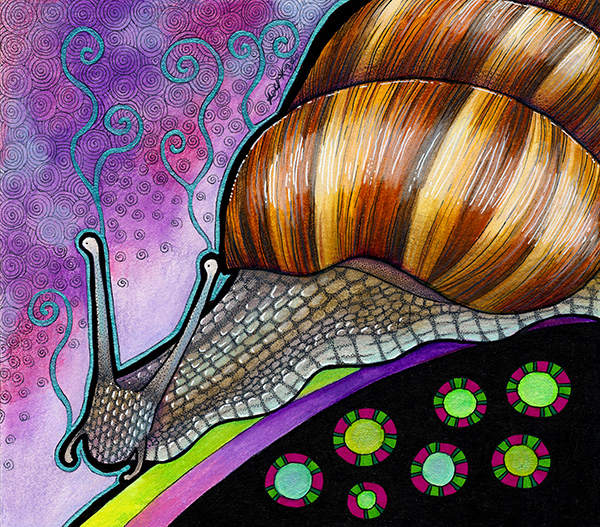Giant African Land Snail – Slow is Fast 
Keywords:
Invasion. Slow is fast. Initially underestimated. Religious offerings. Loved and hated. What are you giving back. Sensuality. Healing touch. Massage. Connection to sacred sexualities. Endurance. Relentlessness. Different connections to different people. You contain multitudes. Many-truths. Sticky situations. Check in on your health.
Description:
The Giant African land snail (sometimes confused with other giant African snails) – Lissachatina fulica (also Achatina fulica) – is a large species of nocturnal snail which, outside of its native range of eastern Africa, is a significant feral pest throughout the world. It is the most invasive species of snail. The Giant African land snail has a shell that varies between 50-10 centimetres, with a width of 10 centimetres at maturity. The body of the snail can sometimes extend up to 30 centimetres in length. Colour variations vary widely depending on what the snail consumes, though there are usually alternating bands of brown and tan.
In the Galapagos and eastern Africa, they prefer to live in high humidity warm tropical climates that are mild all year around. They are found in habitats such as wetlands, coastal regions, agricultural areas, natural and plantation forests, and many other places. During dry or cool weather, they will aestivate in loose soil or under rocks. Giant African land snails primarily herbivorous and eat decaying organic matter, such as fallen fruit, manure, paper, cardboard, even garbage. It has been known to take sand, small rocks, concrete and bones for calcium. Younger snails eat flowers and vegetables and will eat over 500 different species of plant. They will occasionally eat other snails.
As with many other land snails, the Giant African land snail has male and female sex organs, but cannot self-fertilise, so must mate with others. During mating they will pet each other, and press their bodies against each other, with courtship lasting around 30 minutes. They are sexually mature at six months. They can travel well over 100 metres a month, when conditions are favourable. They will also be moved by humans to new locations either by accident, or purposefully, due to the pet trade. Some new populations crop up due to the dumping of pets or their eggs. The Giant African land snail can live for 5-9 years, and may lay a total of 1000 eggs.
They are a disease vector for many different diseases, including those that can cause meningoencephalitis in humans. As a feral pest, it thrives in many different habitats and is a voracious feeder, while often distributing plant diseases, causing severe and catastrophic damage to both farms and native plants. It carries diseases that can harm pets, like rat lungworm, which has been reported to kill dogs who have consumed it. It also competes with native snail species. It is one of the top 100 invasive species in the world. In its native habitat, however, the shells are offered up to the gods in religious rites and festivals.